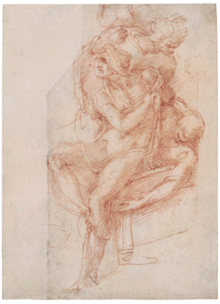The Raising of Lazarus (Sebastiano del Piombo)
 | |
| Artist | Sebastiano del Piombo |
|---|---|
| Year | 1517–1519 |
| Medium | Oil on canvas |
| Dimensions | 381 cm × 299 cm (150 in × 118 in) |
| Location | National Gallery, London |
The Raising of Lazarus is a large altarpiece by the Italian High Renaissance artist Sebastiano del Piombo. It is housed in the National Gallery of London, England.
Painting
In 1516 the archbishop of Narbonne, then Cardinal Giulio de' Medici (later Pope Clement VII), commissioned a Raising of Lazarus from Sebastiano Luciani (as the artist was then called – the nickname del Piombo came in 1531) in competition with Raphael's late masterpiece the Transfiguration, commissioned earlier that year for a church in Rome. In the event, as described by Vasari the Raphael was preferred, and the Sebastiano sent to his cathedral, which it is unlikely he ever visited. As well as following the Transfiguration chronologically, the theme of Lazarus's resurrection was especially appropriate for the cathedral at Narbonne, which had relics of Lazarus. Compositional drawings for the figures of Lazarus and his two attendants were supplied by Michelangelo, who, in addition to being a friend of Sebastiano, was eager to show up his bitter rival Raphael.
Theme

The Gospel of Saint John divides the story of the miracle into three parts: Jesus bids the people take the stone from the tomb, He tells Lazarus to rise, and then He tells him to unbind his shroud. Sebastiano shows the third of these commands. In the background the Pharisees are depicted plotting Christ's death.
Between about 1715 and his death in 1723, the Regent of France, Philippe II, Duke of Orléans, persuaded the Narbonne authorities to let him have the painting for the Orleans Collection in Paris. In 1771 the painting was transferred from wooden panel to canvas and some of the pigments have as a result lost their brightness, most notably the red of Christ's robe, which has turned pink. In the early 19th century The Raising of Lazarus was part of the collection of the London banker John Julius Angerstein. When the Angerstein collection was bought by the British government in 1824 for the foundation of the National Gallery the canvas was catalogued as NG1, making it officially the first painting to enter the National Gallery.
External links
References
- Chambers, David (1970). Patrons and Artists in the Italian Renaissance. London: Palgrave Macmillan UK. pp. 31–34. ISBN 978-1-349-00623-6.
- Langmuir, Erika (2004). The National Gallery Companion Guide. London: National Gallery Company
- Vahland, Kia (2008). Sebastiano del Piombo: a Venetian in Rome (Ostfildern, Germany: Hatje Cantz, 2008), pp. 45–56.